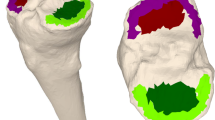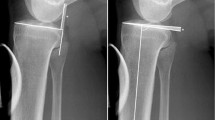Abstract
Background
Precise measurement of the tibial slope (TS) is crucial for realignment surgery, ligament reconstruction, and arthroplasty. However, there is little consensus on the ideal assessment. It was hypothesized that the tibial slope changes according to the acquisition technique and both tibial length as well as femoral rotation serve as potential confounders.
Methods
104 patients (37 women, 67 men; range 12–66 years) were retrospectively selected, of which all patients underwent a 1.5-Tesla MRI and either additional standard lateral radiographs (SLR, n = 52) or posterior stress radiographs (PSR, n = 52) of the index knee. Two blinded observers evaluated the medial tibial slope as the medial TS is primarily used in clinical practice. Additionally, the length of the diaphyseal axis and the extent of radiographic malrotation were measured.
Results
Mean TS on MRI was significantly lower compared to radiographs (4.2° ± 2.9° vs. 9.1° ± 3.6°; p < 0.0001). There was a significant correlation between MRI and PSR (p < 0.0001 with r = 0.7), but not with SLR (p = 0.93 with r = 0.24). Tibial length was a significant predictor for the difference between MRI and SLR (regression coefficient ß = − 0.03; p = 0.035), yet not between MRI and PSR (ß = − 0.003; p = 0.9). Femoral rotation proved to be a significant predictor for the agreement between both observers (PSR: ß = 0.14; p = 0.001 and SLR: ß = 0.08; p = 0.04). ICC indicated a high interrater agreement for the radiographic assessment (ICC ≥ 0.72).
Conclusions
There is a substantial variance between MRI and radiographic measurement of the tibial slope. However, as MRI assessment is time-consuming and requires specialized software, instrumented radiographs might be an alternative. Due care has to be taken to ensure that radiographs contain a sufficient tibial length, and femoral rotation is avoided.
Study design
Case series (diagnosis); Level of evidence, 4.





Similar content being viewed by others
References
Shelburne KB, Kim HJ, Sterett WI, Pandy MG (2011) Effect of posterior tibial slope on knee biomechanics during functional activity. J Orthop Res 29:223–231
McLean SG, Oh YK, Palmer ML, Lucey SM, Lucarelli DG et al (2011) The relationship between anterior tibial acceleration, tibial slope, and ACL strain during a simulated jump landing task. J Bone Jt Surg Am 93:1310–1317
Hashemi J, Chandrashekar N, Gill B, Beynnon BD, Slauterbeck JR et al (2008) The geometry of the tibial plateau and its influence on the biomechanics of the tibiofemoral joint. J Bone Jt Surg Am 90:2724–2734
Jojima H, Whiteside LA, Ogata K (2004) Effect of tibial slope or posterior cruciate ligament release on knee kinematics. Clin Orthop Relat Res 426:194–198
Schatka I, Weiler A, Jung TM, Walter TC, Gwinner C (2017) High tibial slope correlates with increased posterior tibial translation in healthy knees. Knee Surg Sports Traumatol Arthrosc 26(9):2697–2703
Dejour H, Bonnin M (1994) Tibial translation after anterior cruciate ligament rupture. Two radiological tests compared. J Bone Jt Surg Br 76:745–749
Jaecker V, Drouven S, Naendrup JH, Kanakamedala AC, Pfeiffer T, Shafizadeh S (2018) Increased medial and lateral tibial posterior slopes are independent risk factors for graft failure following ACL reconstruction. Arch Orthop Trauma Surg 138(10):1423–1431
Webb JM, Salmon LJ, Leclerc E, Pinczewski LA, Roe JP (2013) Posterior tibial slope and further anterior cruciate ligament injuries in the anterior cruciate ligament-reconstructed patient. Am J Sports Med 41:2800–2804
Wordeman SC, Quatman CE, Kaeding CC, Hewett TE (2012) In vivo evidence for tibial plateau slope as a risk factor for anterior cruciate ligament injury: a systematic review and meta-analysis. Am J Sports Med 40:1673–1681
Salmon LJ, Heath E, Akrawi H, Roe JP, Linklater J, Pinczewski LA (2018) 20-Year outcomes of anterior cruciate ligament reconstruction with hamstring tendon autograft: the catastrophic effect of age and posterior tibial slope. Am J Sports Med 46:531–543
Giffin JR, Stabile KJ, Zantop T, Vogrin TM, Woo SL, Harner CD (2007) Importance of tibial slope for stability of the posterior cruciate ligament deficient knee. Am J Sports Med 35:1443–1449
Gwinner C, Weiler A, Roider M, Schaefer FM, Jung TM (2017) Tibial slope strongly influences knee stability after posterior cruciate ligament reconstruction. Am J Sports Med 45:355–361
Ozel O, Yucel B, Mutlu S, Orman O, Mutlu H (2017) Changes in posterior tibial slope angle in patients undergoing open-wedge high tibial osteotomy for varus gonarthrosis. Knee Surg Sports Traumatol Arthrosc 25:314–318
Lee SY, Lim HC, Bae JH, Kim JG, Yun SH et al (2017) Sagittal osteotomy inclination in medial open-wedge high tibial osteotomy. Knee Surg Sports Traumatol Arthrosc 25:823–831
Singerman R, Dean JC, Pagan HD, Goldberg VM (1996) Decreased posterior tibial slope increases strain in the posterior cruciate ligament following total knee arthroplasty. J Arthroplasty 11:99–103
Meric G, Gracitelli GC, Aram L, Swank M, Bugbee WD (2015) Tibial slope is highly variable in patients undergoing primary total knee arthroplasty: analysis of 13,546 computed tomography scans. J Arthroplasty 30:1228–1232
Sturnick DR, Van Gorder R, Vacek PM, DeSarno MJ, Gardner-Morse MG et al (2014) Tibial articular cartilage and meniscus geometries combine to influence female risk of anterior cruciate ligament injury. J Orthop Res 32:1487–1494
Elmansori A, Lording T, Dumas R, Elmajri K, Neyret P, Lustig S (2017) Proximal tibial bony and meniscal slopes are higher in ACL injured subjects than controls: a comparative MRI study. Knee Surg Sports Traumatol Arthrosc 25:1598–1605
Faschingbauer M, Sgroi M, Juchems M, Reichel H, Kappe T (2014) Can the tibial slope be measured on lateral knee radiographs? Knee Surg Sports Traumatol Arthrosc 22:3163–3167
Ewald FC (1989) The Knee Society total knee arthroplasty roentgenographic evaluation and scoring system. Clin Orthop Relat Res 248:9–12
Kessler MA, Burkart A, Martinek V, Beer A, Imhoff AB (2003) Development of a 3-dimensional method to determine the tibial slope with multislice-CT. Z Orthop Ihre Grenzgeb 141:143–147
Hudek R, Schmutz S, Regenfelder F, Fuchs B, Koch PP (2009) Novel measurement technique of the tibial slope on conventional MRI. Clin Orthop Relat Res 467:2066–2072
Lipps DB, Wilson AM, Ashton-Miller JA, Wojtys EM (2012) Evaluation of different methods for measuring lateral tibial slope using magnetic resonance imaging. Am J Sports Med 40:2731–2736
Jacobsen K (1976) Stress radiographical measurement of the anteroposterior, medial and lateral stability of the knee joint. Acta Orthop Scand 47:335–344
Shrout PE, Fleiss JL (1979) Intraclass correlations: uses in assessing rater reliability. Psychol Bull 86:420–428
Cicchetti DV (1994) Guidelines, criteria, and rules of thumb for evaluating normed and standardized assessment instruments in psychology. Psychol Assess 6:284
Hofmann AA, Bachus KN, Wyatt RW (1991) Effect of the tibial cut on subsidence following total knee arthroplasty. Clin Orthop Relat Res 269:63–69
Matsuda S, Miura H, Nagamine R, Urabe K, Ikenoue T et al (1999) Posterior tibial slope in the normal and varus knee. Am J Knee Surg 12:165–168
Weinberg DS, Williamson DF, Gebhart JJ, Knapik DM, Voos JE (2016) Differences in medial and lateral posterior tibial slope an osteological review of 1090 tibiae comparing age, sex, and race. Am J Sports Med 45(1):106–113
Akamatsu Y, Sotozawa M, Kobayashi H, Kusayama Y, Kumagai K, Saito T (2014) Usefulness of long tibial axis to measure medial tibial slope for opening wedge high tibial osteotomy. Knee Surg Sports Traumatol Arthrosc 24(11):3661–3667
Ahmad R, Patel A, Mandalia V, Toms A (2016) Posterior tibial slope: effect on, and interaction with, knee kinematics. JBJS Rev 4:e31–e36
Utzschneider S, Goettinger M, Weber P, Horng A, Glaser C et al (2011) Development and validation of a new method for the radiologic measurement of the tibial slope. Knee Surg Sports Traumatol Arthrosc 19:1643–1648
Acknowledgements
We thank the Institute for Radiology and Department of Nuclear Medicine of the Charité-University Medicine Berlin for their continuous support and image allocation.
Author information
Authors and Affiliations
Corresponding author
Ethics declarations
Conflict of interest
The authors declare that they have no conflicts of interest in the authorship and publication of this contribution.
Additional information
Publisher’s Note
Springer Nature remains neutral with regard to jurisdictional claims in published maps and institutional affiliations.
Rights and permissions
About this article
Cite this article
Gwinner, C., Fuchs, M., Sentuerk, U. et al. Assessment of the tibial slope is highly dependent on the type and accuracy of the preceding acquisition. Arch Orthop Trauma Surg 139, 1691–1697 (2019). https://doi.org/10.1007/s00402-019-03201-y
Received:
Published:
Issue Date:
DOI: https://doi.org/10.1007/s00402-019-03201-y




